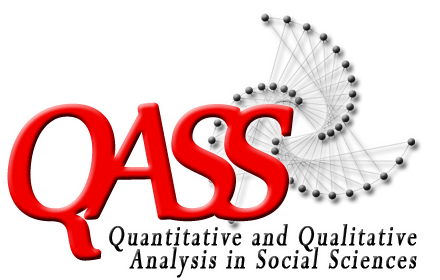Guide for Authors
How to Submit
Papers may be submitted to any editor who will thereafter process the work. Editors’ areas of interest are listed below. Papers should be addressed to:
Menelaos Karanasos (Econometrics/Finance) menelaos@qass.org.uk
John Hatgioannides (Finance) John@qass.org.uk
George Kapetanios (Econometrics/Economics) george@qass.org.uk
Marika Karanassou (Economics) marika@qass.org.uk
The paper must be submitted as a PDF file. Final version will only be accepted as Scientific Word or Word files.
Manuscript Style
The language of the journal is English. Please note that, in general, papers should not exceed 7,500 words, including diagrams, figures, tables, etc. Overlong papers will be returned without consideration.
All submissions must be printed on one side of the paper, be double-line spaced and have a margin of 3cm all round. All pages should be numbered consecutively. Titles and subtitles should be short. References, tables, and illustrations should be printed on separate sheets, and not be incorporated into the text. The legends and titles on tables and figures must be sufficiently descriptive such that they are understandable without reference to the text.
The first page of the manuscript should contain the following information: (i) the title; (ii) the name(s) and institutional affiliation(s) of the author(s); (iii) an abstract of not more than 40 words. Affiliations should be marked as a, b, c, etc. A footnote on the same sheet should give the full address, including e-mail, telephone and fax, of the corresponding author.
The first page of the manuscript should include up to five keywords that describe your paper for indexing purposes. For economics and finance related submission include at least one standard JEL code.
Acknowledgements and information on grants received should be given in a footnote on the first page of the manuscript.
Footnotes in the text must be numbered consecutively with superscript Arabic numerals. They must be typed double-spaced and should be kept to a minimum.
Equations must be numbered consecutively throughout the manuscript on the right margin, using Arabic numerals in parentheses. In cases where the derivation of formulae has been abbreviated, it is of great help to the referees if the full derivation can be presented in a separate word file (not to be published).
Reference style
All references must be complete and accurate.
References to publications in the text should appear as follows: ‘Jarrow and Rudd (1989) propose the use…’ or ‘…application of the panel test of Im, Pesaran and Shin (2003)…’.
Where reference is made to more than one work by the same author published in the same year, identify each citation in the text as follows: Phillips (2005a), Phillips (2005b). The author(s) should make sure that there is a strict one-to-one correspondence between the names and years in the text and those on the list.
The list of references should appear at the end of the main text (after any appendices, but before figures and tables). In the references list, references should be arranged first alphabetically and then further sorted chronologically if necessary.
References should be listed in the following style:
Reference to a book:
Altman E., and E. Hotchkiss (2006). Corporate Financial Distress and Bankcrupty. Wiley, Hoboken, New Jersey.
Mills T. C., and K. Patterson, Eds, (2006). Palgrave Handbook of Econometrics Vol. 1. Palgrave MacMillan, New York.
For contributions to collective works:
Haldrup N., and M. Jansson (2006). Improving Size and Power of Unit Root Tests, in Palgrave Handbook of Econometrics, T. C. Mills and K. Patterson (Eds), Palgrave Macmillan, New York.
Reference to a journal publication:
Baillie R. T., and T. Bollerlev (1989). The Message in Daily Exchange Rates: A Conditional Variance Tale. Journal of Business & Economic Statistics, 7, 297-305. (Note that journal titles should not be abbreviated).
Citing and listing of Web references:
As a minimum, the full URL should be given. Any further information if known should also be given.
Each table must be titled and numbered consecutively with Arabic numerals. All unessential tables should be eliminated from the manuscript. Please check the text to make sure there is a reference to each table. The author(s) should check tables to be sure that the title, column headings, and footnotes clearly explain the content of the table.
Figures must be titled and numbered consecutively with Arabic numerals. Captions should present sufficient information to describe the purpose of the figure. Figures for accepted manuscripts must be of professional quality and ready for reproduction. As all proofreading will be done by the Journal’s staff and no proofs will be sent to the Author, the presentation of the manuscripts should be very clear.
The author(s) should check the manuscript for clarity, grammar, spelling, and punctuation to minimize editorial changes and the necessity of extensive corrections at the proof stage.
Order:
When you create your manuscript, please make sure it is in the following order: • Title • Authors • Affiliation • Abstract
- JEL classifications
- Keywords • Main Text • Appendix • References • Figures • Tables
Submission checklist: • Full postal address • Telephone • E-mail address • JEL code(s) and Keywords • All figure captions • All tables • Manuscript has been “spellchecked” • References are in the correct format for this journal • All references mentioned in the Reference list are cited in the text, and vice versa.
Any manuscript which does not conform to the above instructions may be returned for the necessary revision before publication.
Copyright
Authors submitting a paper to Quantitative and Qualitative Analysis in Social Sciences (QASS) automatically agree to confer a limited license to Quantitative and Qualitative Analysis in Social Sciences (QASS) if and when the manuscript is formally accepted for publication. The following license allows Quantitative and Qualitative Analysis in Social Sciences (QASS) to publish a manuscript in a given issue.
Authors should consent to the following paragraph via Email to the Editorial Board of Quantitative and Qualitative Analysis in Social Sciences (QASS):
“I hereby (…name of author(s)…) agree that my(our) paper (…titled…) will be only published in the Quantitative and Qualitative Analysis in Social Sciences(QASS). I (We) am (are) willing to dedicate the copyright of my (ours) aforementioned article to your journal.”
Authors submitting a paper to Quantitative and Qualitative Analysis in Social Sciences (QASS) do so in the understanding that Internet publishing is both an opportunity and challenge. In this environment, authors and publishers do not always have the means to protect against unauthorised copying and editing of copyright-protected works.
Copyright © Quantitative and Qualitative Analysis in Social Sciences (QASS), Quantitative and Qualitative Analysis in Social Sciences (QASS) is a copyrighted compilation, and all rights are reserved. Permissions to reprint or use full issues of Quantitative and Qualitative Analysis in Social Sciences(QASS) should be directed to the Editorial Board.

